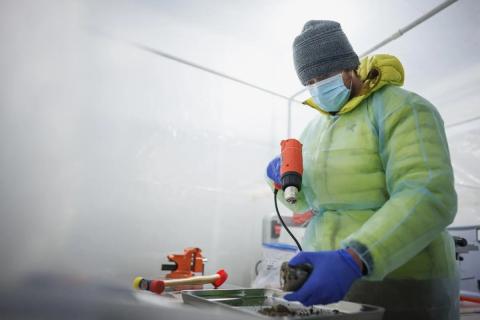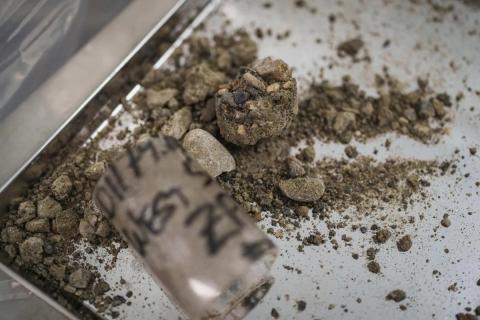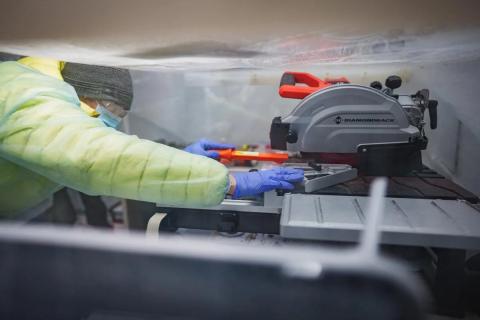Class of 2025 HCUR Alum: Torin Scalora (Environmental Sciences: Ecosystems)
In this series, we hear from three graduating Hamel Center students about the research they completed during their time as undergraduates and what’s next for them now that commencement has passed.
What is your research about?

My research investigated the ways that depth and salinity structure microbial communities in three 30-meter-deep permafrost cores, with each core being a different type of permafrost (subsea, brackish and terrestrial). Permafrost, which is soil that is perennially frozen year-round, is an essential component of the global carbon cycle as it contains a carbon stock equal to the size of the atmospheric carbon stock. Microorganisms in permafrost are also active players in the carbon cycle, as they are capable of both carbon fixation and respiration, making them an integral part of the cycle. Microbial communities inhabiting permafrost are still being investigated, and with the Arctic warming up to four times faster than the rest of the planet, it is crucial to study the microbial diversity currently found within permafrost to understand carbon dynamics better.

Research on permafrost microbial communities this deep beneath the surface is relatively novel because of the difficulty in extracting permafrost cores deeper than a meter or two. The permafrost cores I examined came from Alaska’s North Slope. My research took place in Dr. Ernakovich’s lab at UNH and was funded by a Summer Undergraduate Research Fellowship (SURF).
What did you learn?
I learned quite a bit about both the topic and the research process. I expanded my understanding of permafrost formation and classifications, the importance of various environmental factors such as pH and total organic carbon on community composition, and the importance of permafrost in the global carbon cycle. The biggest takeaway from this research was seeing how a research project is conducted from start to finish. I plan to keep researching permafrost soils and microbial communities, so learning about the whole research process was eye-opening. Learning how to put together an effective proposal, troubleshoot problems as they arise, analyze data and present findings so early in my scientific career was challenging, but it also gave me a strong foundation that I’ll carry forward.
What was the best part of your research project?
The best part of this project was how much I learned throughout the entire process. I learned something new at every stage, from reading countless papers and designing the study to analyzing the data and presenting it at the American Geophysical Union Annual Meeting. At times, it felt quite challenging to absorb the critical information required to move forward, but this made me a more effective researcher and more passionate about my work.
What was the most challenging part of your research project?
The most challenging aspect was managing logistics and lab work. Coordinating equipment usage, learning lab protocols, processing samples, and maintaining a tight schedule took a lot of patience and problem-solving. I often thought back to these challenges while completing coursework in my senior year. While it was difficult, working through those obstacles has already proven to be invaluable.
How did you prepare to present your research?
Preparing to present this project meant revisiting key papers that helped formulate questions and design the study. I worked closely with others in the Ernakovich lab to ensure the presentation was clear and concise and included all necessary information. I also practiced my presentation with my girlfriend, which helped me to refine my delivery and remove jargon that others may not be familiar with.
What’s next for you?

This project deepened my interest in extreme environments and how organisms survive in them. It feels natural for me to keep exploring these systems and investigate microbial interactions with elemental cycles, how life persists in harsh conditions and how the Arctic is responding to a rapidly warming climate. I am still working with the data collected during this fellowship and hope to publish the results.
This summer I’ll be working part-time with the Ernakovich lab as a technician. I’m also building a study/review resource for the Military and Veterans Center on campus for incoming veteran students to brush up on topics such as biology or algebra, which many veterans haven’t studied or used since before they joined the military. Finally, I’m looking for volunteer opportunities to work with local veterans and build a stronger sense of community within the Seacoast veteran population. My overarching goal is to help other veterans find STEM career paths that work for them, ideally by establishing a nonprofit to prepare veterans and servicemembers preparing to transition into STEM degrees. That goal is more long term, so I’m trying to lay the groundwork now by just getting more active in the community.
As for graduate school, I’ve decided to stay with UNH and the Ernakovich lab to continue studying permafrost microbial communities for my PhD. I’m looking forward to my time as a graduate student at UNH, and I’m grateful for having found such a dedicated and supportive lab so early in my college career. Permafrost is such an interesting environment that holds unique challenges, making it hard for life to persist. I’ve always been fascinated with the extreme limits of life, and I couldn’t picture myself studying anything else.